Takeaways from “The Podcast Consumer 2018” by Edison Research

Last week, Edison Research debuted their annual podcast report, The Podcast Consumer. It’s a segmented report using the same data they glean from their Infinite Dial Report — specifically focusing on podcasts and tangential trends. We analyzed the Infinite Dial Report and came away with our own conclusions in their relations to podcasts, but this new data splice represents new findings and new analysis.
Here’s the good, the bad, and the interesting when it comes to podcast trends.
Podcast Growth
We covered this in the last post, but it’s worth repeating. Podcasts continues to grow at a slow and steady pace. I wrote this earlier, but a 4% gain is nothing to scoff at.
Podcast listening continues to grow as well. If you’re new to The Infinite Dial and very much live in the echo chamber I described above, 44% might seem low to you. However, a 4% rise matches the highest historical leap from 2017 — this bodes extremely well for the podcast industry

Earlier this month, I wrote about how to expand the podcast industry with new marketing techniques. I’ve received some great feedback both agreeing with my premise and providing thoughtful critiques. The growth of podcasts is the main statistic from the Edison reports I watch (and has become an industry benchmark), but in an ideal situation the industry would grow at a more accelerated pace.
Where People Listen
It’s always interesting to get a sneak peak into how others listen to podcasts. There’s nothing incredibly eye-popping from the results of the locations podcasts are listened to the most. I will say I’m surprised by the dominance of at-home podcast listeners. While I do listen at home, it’s likely my third-most listened destination.

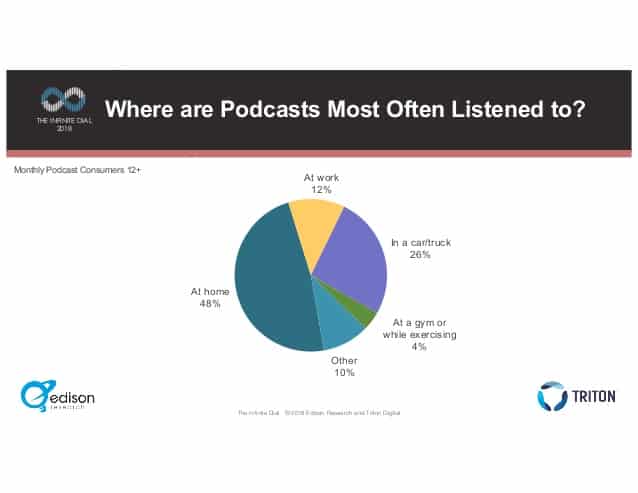
The at home responses dovetail nicely into an area I find most interesting: smart speakers.
Podcasts on Smart Speakers
Smart speaker adoption among podcast fans in undeniable. The connection is magnified when compared to the overall US population as well. 30% of monthly podcast listeners own a smart speaker, compared with 18% of the US population.
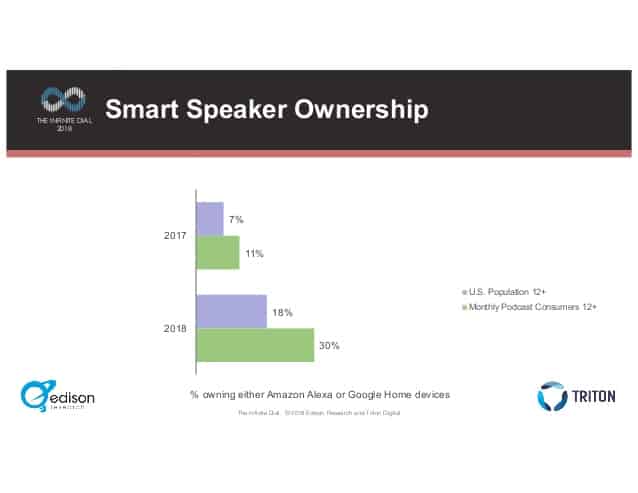
Edison also gives a preview of an upcoming report in a partnership with NPR, The Smart Audio Report. The interesting data point they discuss is only 24% of monthly podcast listeners who own a smart speaker listen to podcasts on the smart speaker. They find this odd because theoretically it should be 100% since the respondents listen to podcasts and own a smart speaker. However, I disagree.

What I think the analysts at Edison get wrong here, however, is the correlation versus causation. This will get anecdotal, but my hunch is that my use cases likely mirror others out there. I own a first-generation Amazon Echo and an Echo Dot and use them both daily. I listen to podcasts daily. I have never listened to a podcast on a smart speaker. I don’t imagine I will anytime soon.
The analysts are correct to point out the existing friction of listening to a podcast on a smart speaker, Amazon Alexa in particular. There are few skills and workarounds to listen in a convenient manner. But I think they’re ignoring the why people own smart speakers and what I’ll assume is a small overlap with the why people listen to podcasts.
I mentioned earlier I listen to podcasts at home, but not as often as other places. When I do listen at home, it’s because I’m doing chores around the house. I have my headphones on and my phone in my pocket. The other places I listen to podcasts are mainly during my morning workout and on my daily commute. The common thread of all these use cases is I’m on the go. I’m moving around. Smart speakers are stationary.
The other thing smart speakers aren’t (for the most part): good speakers. I mentioned I use my Echos on a daily basis, but they usually don’t have much to do with the speaker part. I use them to look up random facts, as a timer while I cook, weather/news report, and home automation. Occasionally, I’ll get my flash briefing, and that’s probably the closest I’ve come to listening to a podcast on my smart speakers.
I could be an edge case here and we’ll see a meteoric rise of podcast listening on smart speakers, but as it stands right now, I don’t see the appeal.
How People Listen
Along with smart speakers, there are some new trends in listener behavior I find pretty interesting. The first segment is years listening to podcasts spliced with the frequency of podcast listening. What you see in the chart below is basically the longer you’ve been a podcast fan the more often you listen to podcasts. This might seem trivial, but I think it’s a proof-point at a very encouraging trend, podcasts are good and create loyal followers.
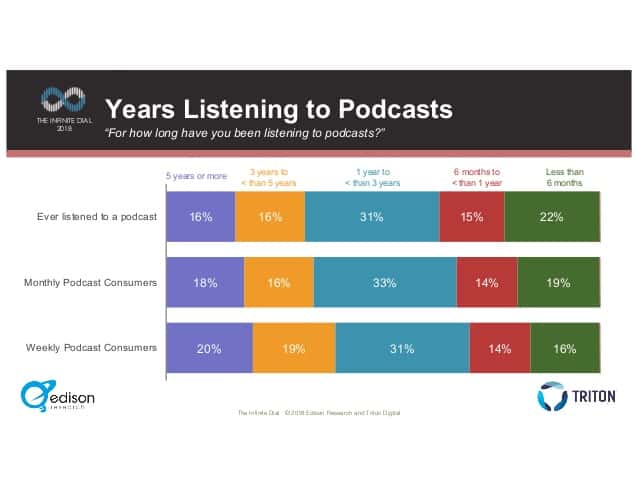
I don’t mean “loyal followers” as in an individual podcast listener being loyal to a specific podcast (while I’d argue this is probably still true). Instead, I mean once people start listening to podcasts as a whole, they’re hooked to the medium at large. As simplistic as this sounds, it’s a very good trend line for everyone involved. In the podcast marketing piece I hypothesized this as a possibility. Creating new podcast listeners by creating new habits is a worthwhile endeavor. “Grow the dominator” as Pacific Content’s Dan Misener puts it, will produce long-term dividends.
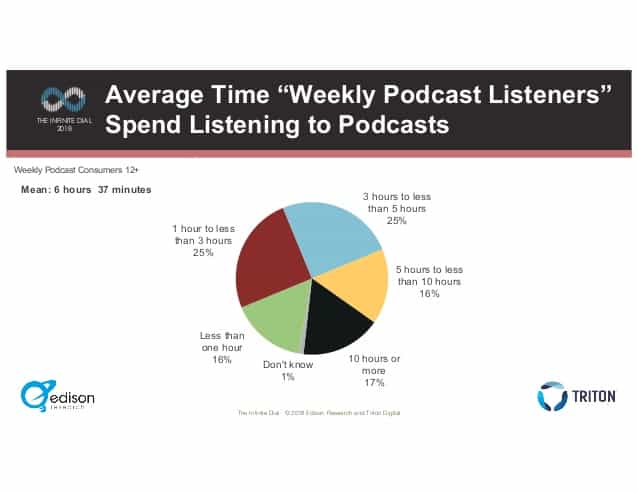
Another interesting stat is the average time weekly podcast listeners listen to podcasts, 6 hours and 37 minutes. Up from approximately 5 hours. People are listening to more podcasts for a longer period of time. Again, another good sign for the industry. I am a bit curious however, as to what time they’re measuring here. They go on to analyze the abundance of speed listeners (19%). I assume the time in the above chart is actual time versus podcast time — the discrepancy for those who speed listen.
Edison highlighted a statistic I’m still unsure of. Their bespoke metric coined Share of Ear is a breakdown of the frequency between different audio options people listen to. How do podcasts measure to music streaming, for example. Among the US population, podcasts’ Share of Ear doubled in four years from 2% to 4%. A good trend, for sure, but I don’t think it’s all that significant.
What Advertisers Care About
Reports like these are extremely important for podcasts looking to monetize or increase their podcast business. Individual podcast metrics — like Apple is slowly rolling out — are great to show a specific podcast, but deep-pocked advertisers need to place their bet on the industry as a whole.
Everything in this report is great news for advertisers … and subsequently podcasters. First and foremost, people listen. 87% of podcast listeners listen to most or all of the podcast. Along with this, podcast listeners remain the audience advertisers lust over: affluent, educated, working people who skew on the younger side.


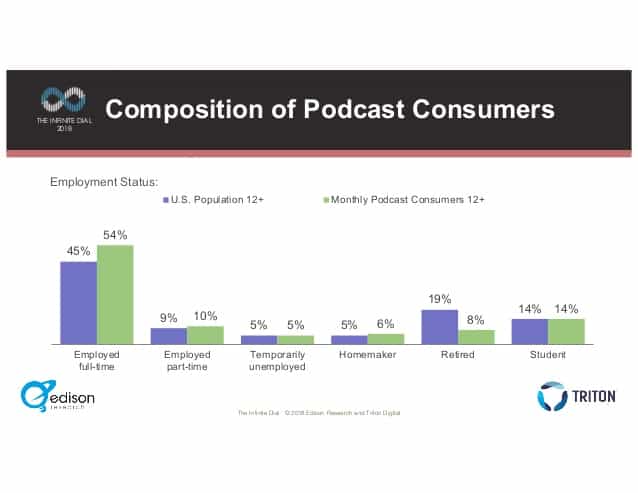
Here’s the full report from Edison Research:





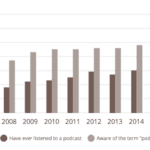
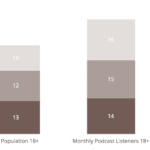
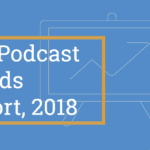





Comments
Comments are closed.